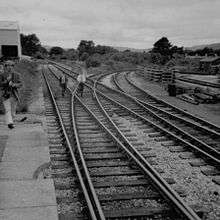Teign Valley Line
| Teign Valley Line | |||||||||||||||||||||||||||||||||||||||||||||||||||||||||||||||||||||||||||||||||||||||||
|---|---|---|---|---|---|---|---|---|---|---|---|---|---|---|---|---|---|---|---|---|---|---|---|---|---|---|---|---|---|---|---|---|---|---|---|---|---|---|---|---|---|---|---|---|---|---|---|---|---|---|---|---|---|---|---|---|---|---|---|---|---|---|---|---|---|---|---|---|---|---|---|---|---|---|---|---|---|---|---|---|---|---|---|---|---|---|---|---|---|
Legend | |||||||||||||||||||||||||||||||||||||||||||||||||||||||||||||||||||||||||||||||||||||||||
| |||||||||||||||||||||||||||||||||||||||||||||||||||||||||||||||||||||||||||||||||||||||||

The Teign Valley Line was a single track railway line that ran from Heathfield, Devon to Exeter via the Teign Valley. It joined the South Devon main line at Exeter City Basin Junction.
History
Opening
The Teign Valley Railway Company was given Royal Assent in 1863 and opened on 9 October 1882, branching from the Moretonhampstead and South Devon Railway's station at Heathfield, to Christow. In 1903 the line was extended to Exeter. It served mineral quarries in the valley and had a passenger service. For a brief time there was an engine shed at Ashton.
Decline
The mineral traffic that had provided much of the line's revenues was also its downfall, as the quarries provided roadstone for Devon's expanding and improving road network. In the 1920s and 1930s, the new motor bus services meant that passenger traffic dwindled. The mineral traffic soon followed. Meanwhile, the Great Western Railway placed camp coaches in some of the stations providing holiday accommodation. A small station was opened at Chudleigh Knighton Halt on 9 June 1924.
Closure
The line saw a resurgence of traffic during the restrictions and petrol rationing after the Second World War however passenger trains were withdrawn in June 1958. This was five years before the publication of The Reshaping of British Railways which led to the closure of many similar routes. Flooding caused the line to be closed entirely between Christow and Exeter in 1961, following which the gradual withdrawal of freight saw the line finally close in 1967.
The route
When operational
The line followed a sinuous course from Heathfield to Exeter, which was the Up direction. From Ashton the line climbs considerably to Longdown, with a long stretch at 1 in 64. From Longdown the line falls at 1 in 58 for several miles.
There were two tunnels at Longdown; Culver Tunnel (248 yards, 227 m) to the west and Perridge Tunnel (836 yards, 764 m) to the east of Longdown.
- Heathfield was a station on the Moretonhampstead line (the Moretonhampstead and South Devon Railway). It had been known as Chudleigh Road but was renamed when it became the junction point. At first the Teign Valley line ran to a bay platform only, with a shunting move the only means of connecting to the other route. This was altered to a running junction on 2 October 1916. It was made a full double junction from May 1943; the intention was to make the line a diversionary route if the Dawlish route should become blocked by enemy action.[1]
- Chudleigh Knighton Halt. Opened 9 June 1924.
- Chudleigh.
- Trusham. There was a short passing loop, and this was much extended in 1943 in connection with the diversionary arrangement referred to above. There was a considerable quarry here, and also at Whetcombe, a short distance towards Exeter.
- Ashton. Originally the northern terminus of the line until 1903.
- Christow.
- Dunsford Halt. Opened 16 January 1928. It was almost two miles (three km) from the village.
- Longdown. Reduced to Longdown Halt on 1 October 1923.
- Ide . Opened 1 July 1903, degraded to a Halt in 1923,
- Alphington Halt. Opened 2 April 1928.
- City Basin Junction was the junction with the Dawlish main line to Exeter.[1]
Today
The A38 road covers some of the route near to Chudleigh, the intersection on the A38 at this point is named "Chudleigh Station". A short section of the line in Exeter, known as the "Alphington Spur" remains a siding for weekly scrap metal freight trains. In December 2012 there has been an outline planning proposal by the council to open a new station on the main line close to this section of the old line to serve Exeter's Marsh Barton Trading Estate. At Christow Station there is a reconstruction project. Many of the stations and some of the line's infrastructure still persist. Alphington Halt was completely demolished, but it is still possible to see the remains of the bridges over Church road and Ide lane, and the long curving embankment which now runs beside the Alphington spur connection to the A30. The same fate awaited Ide Halt, with St. Ida's Close now built over the station site. Longdown station however survives in remarkably good condition. Perridge Tunnel is blocked, but the shorter Culver Tunnel is open. Dunsford halt was demolished, but the stations at Christow, Ashton and Trusham station are all still extant having been converted to dwellings. The stations at Chudleigh, Chudleigh Knighton Halt and Heathfield did not survive.
Revival of the Teign Valley Line could be an option that might be considered in the wake of widespread disruption caused by damage to the mainline track at Dawlish by coastal storms in February 2014. Transport Secretary Patrick McLoughlin ordered a review of alternative inland rail routes.[2]
References
- 1 2 Mitchell, Vic; Smith, Keith (December 1998). Branch Line to Moretonhampstead, including Heathfield to Exeter. Midhurst: Middleton Press. . ISBN 1 901706 27 3.
- ↑ http://www.bbc.co.uk/news/uk-england-26110559 BBC News: Network Rail chooses Dawlish alternative route; 10 Feb 2014
- Pomroy, L W (1984). The Teign Valley Line. Poole: Oxford Publishing Co. ISBN 0-86093-194-3.
- Kay, Peter (1996). The Teign Valley Line. Didcot: Wild Swan Publications. ISBN 1-874103-28-3.
- Jenkins, S C; Pomroy, L J (1989). The Moretonhampstead and South Devon Railway. Oxford: Oakwood Press. ISBN 0-85361-389-3.
- Fenton, Mike (1999). Camp Coach Holidays on the GWR. Didcot: Wild Swan Publications. ISBN 1-874103-53-4.